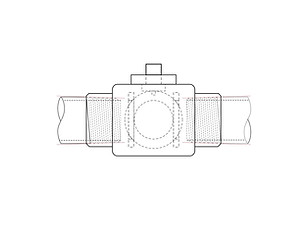
What is Valve?
Valves are mechanical devices that control the flow and pressure within a system or process. They are essential components of a piping system that conveys liquids, gases, vapors, slurries, etc..
Different types of valves are available: gate, globe, plug, ball, butterfly, check, diaphragm, pinch, pressure relief, control valves, etc. Each of these types has a number of models, each with different features and functional capabilities. Some valves are self-operated while others manually or with an actuator or pneumatic or hydraulic is operated
Types of Valves

GATE VALVE
Gate valves are primarily designed to start or stop flow, and when a straight-line flow of fluid and minimum flow restriction are needed.

BALL VALVE
A Ball valve is a quarter-turn rotational motion valve that uses a ball-shaped disk to stop or start flow.

CHECK VALVE
Check valves are automatic valves that open with forward flow and close with reverse flow.

GLOBE VALVE
A Globe valves is a linear motion valve and are primarily designed to stop, start and regulate flow.

BUTTERFLY VALVE
A Butterfly valve is a quarter-turn rotational motion valve, that is used to stop, regulate, and start flow.

NEEDLE VALVE
Needle Valves are used to make relatively fine adjustments in the amount of fluid flow.
Classification of Valve Base on End Connection Types

SCREWED END
The screwed end is a simple connection method often used for small valves. This connection is usually made by machining the valve in and out of the end into tapered or straight pipe threads, which can be connected to tapered pipe threads or the pipeline. Since this connection may have large leakage channels, sealant, sealing tape or packing can be used to plug these channels. If the material of the valve body is weldable but the expansion coefficient varies greatly, or the operating temperature varies widely, the threaded joint must be honey sealed. Thread connected valves are mainly nominal through the valve in the 50mm or less. If the size is too large, it is very difficult to install and seal the connecting parts. To facilitate installation and removal of threaded valves, pipe connections are available at appropriate locations in the piping system. Valves with nominal sizes up to 50 mm May be fitted with a sleeve, where the thread holds the two parts together.

FLANGED END
Flanged ends are the most commonly used type of valve end connection. Flanged valve installation and disassembly are more convenient. But they are heavier and more expensive than threaded valves. Therefore it is suitable for pipe connections of all sizes and pressures. However, when the temperature exceeds 350 degrees, because the bolts, gaskets and flanges become slack, also significantly reduce the load of the bolts, the flange connection may produce leakage under great stress.

WELDED END
Welded end connection is suitable for all kinds of pressure and temperature, and is more reliable than flange connection when used under the condition of higher load. However, soldered valves are difficult to remove and reinstall, so their use is usually limited to long-term reliable operation, or use conditions at high temperatures. Such as thermal power stations, nuclear energy projects, ethylene projects on the pipeline. Welded valves with nominal size below 50mm usually have a welding socket to carry the pipe at the flat end of the load. Due to the gap formed between the socket and the pipe, the gap may be corroded by some medium, and the vibration of the pipe may make the joint fatigue, so the use of socket welding is limited. In the larger nominal diameter, the use of conditions engraved, high temperature occasions, the valve body often used groove on the welding, at the same time, the welding seam has the original requirements, must choose a skilled welder to complete the work.
